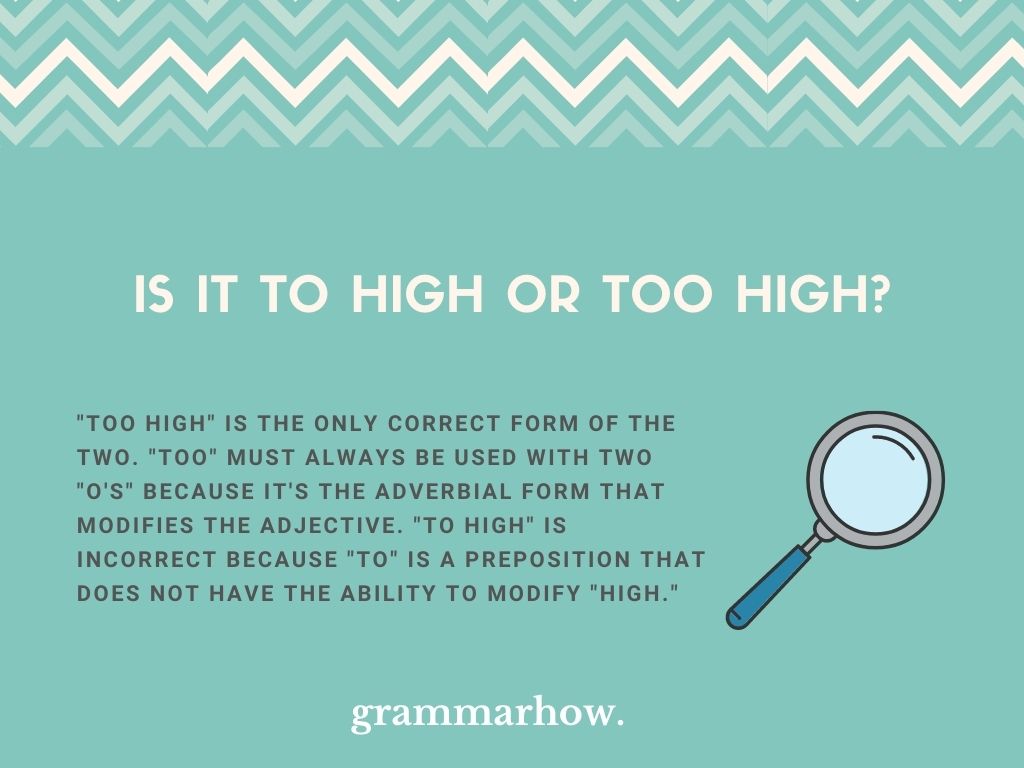Be careful when you are using “too” and “to.” Many people get the two spelling confused, but it’s better to remember how they work before you end up getting them wrong. This article will explain how “too high” works (and how “to high” doesn’t).
Is It To High or Too High?
“Too high” is the only correct form of the two. “Too” must always be used with two “O’s” because it’s the adverbial form that modifies the adjective. “To high” is incorrect because “to” is a preposition that does not have the ability to modify “high.”

Here’s a quick example to help you figure out more about it how “too” works:
- Correct: I’ve put it too high up for the children to reach it.
- Incorrect: That is way to high! Do you not think it would be better if it was lower down?
“Too” is an adverbial form, and it modifies “high” by showing that something is out of reach. It’s the only correct spelling.
“To,” on the other hand, is a preposition. While it can work in sentences for other reasons, it is never correct when modifying adjectives.
To High
“To high” is not correct, as “to” is a preposition. Prepositions cannot modify adjectives like “high” in any particular way. You should avoid using this form because it does not work well when you are trying to show that something is out of reach.
- Correct: It’s too high up there! We really have to be careful with this because it could lead to quite a bad injury.
- Incorrect: I think it’s way to high for you to do it alone. Sorry, but I just don’t think you have the skills to get there.
- Correct: That mountain peak is too high for my first excursion! Maybe we can find one that’s a little smaller to get done first?
- Incorrect: It’s to high. I need someone to come along who will be able to help me get it down. Is that too much to ask?
- Correct: You’ve put it too high up! It’s out of reach for most of the people around here because you’re the tallest of us all!
- Incorrect: Nope! To high for me! I’m not going to overstretch myself to get up there.
Too High
“Too high” is correct because it combines an adverb and an adjective form together. “Too” is an adverb that works by emphasizing the original meaning of an adjective. In this case, it refers to something being out of reach for someone because of its height.
“Too” is the only way you can spell the adverb. If you find yourself writing “to” for any reason, you know you’ve made a mistake.
- It’s way too high for me to reach! I think we’ll have to find a ladder to get to it; otherwise, I’m pretty sure it’ll be a lost cause.
- It’s too high up there! Is there anyone else who is quite tall around here who might be able to help us get this down?
- I think it’s too high to climb efficiently. I definitely do not have the correct lung capacity to get up the mountain without training.
- It’s too high, man! Way too high! I can’t get up there without a little bit of help. Maybe you can come with me?
- If it’s not too high for you to reach, do you mind getting this down for me? I can’t quite seem to get it myself!
Why Do People Tend To Spell It Wrong?
People often spell “to” and “too” wrong, so don’t feel like you’re alone if you’re doing it yourself. It’s something that takes practice, but it’s so common because of how similar the two words sound when they are pronounced aloud (they both sound like the number “two”).
How To Remember If The Correct Spelling Is “To High” or “Too High”
“Too” means “an excessive amount” whenever it’s used to modify an adjective. The way to remember this spelling is to remember that “too” also has an excessive amount of “O’s” when compared to the prepositional form of “to.” That’s why it’s the only form you can use.
Final Thoughts
Make sure that only “too high” appears in your writing. It’s the only form that makes grammatical sense. “To high” is never correct, so you should avoid using it. We can only use adverbs like “too” when modifying adjectives like “high.” Prepositions do not do the same thing.
You may also like:
To Kind or Too Kind? Grammar Explained (Helpful Examples)
To Small or Too Small? Grammar Explained (Helpful Examples)
To Scared or Too Scared? Grammar Explained (With Examples)

Martin holds a Master’s degree in Finance and International Business. He has six years of experience in professional communication with clients, executives, and colleagues. Furthermore, he has teaching experience from Aarhus University. Martin has been featured as an expert in communication and teaching on Forbes and Shopify. Read more about Martin here.
